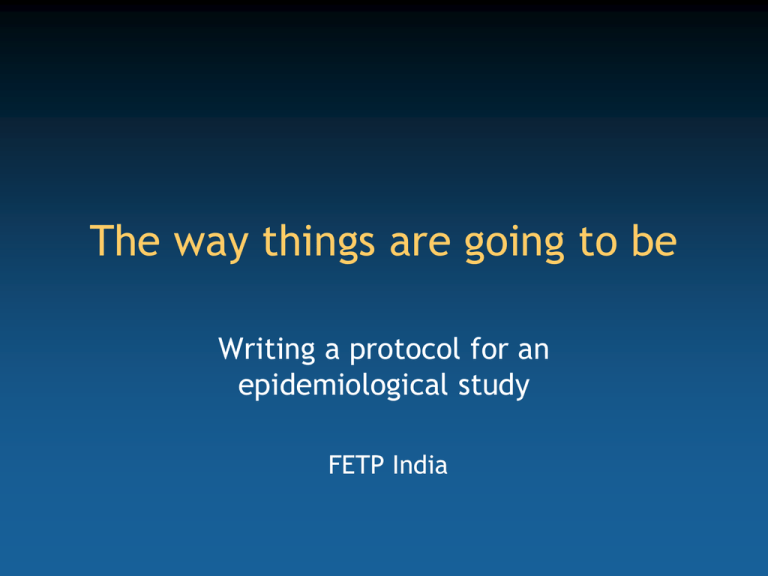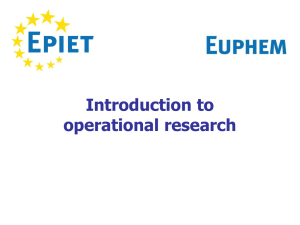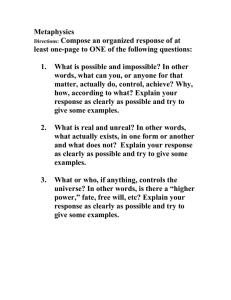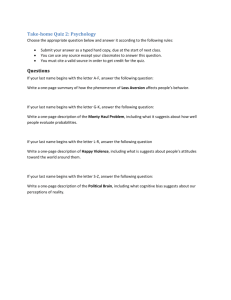Writing Protocol
advertisement

The way things are going to be Writing a protocol for an epidemiological study FETP India Competency to be gained from this lecture Write a protocol for an epidemiological investigation Key areas • Concept paper • First draft of the protocol • Review The seven steps of a successful protocol 1. 2. 3. 4. 5. 6. 7. Identify topic, question and objectives Outline a one-page concept paper Prepare dummy tables Write draft protocol Prepare instruments and annexes Submit to peer review Seek ethical committee clearance The seven steps of a successful protocol 1. 2. 3. 4. 5. 6. 7. Identify topic, question and objectives Outline a one-page concept paper Prepare dummy tables Write draft protocol Prepare instruments and annexes Submit to peer review Seek ethical committee clearance The life cycle of an epidemiological investigation Identifying data needs Involving the programme Spelling out the research question Formulating recommendations Formulating the study objectives Drawing conclusions Planning the analysis Analysing data Preparing data collection instruments Collecting data Working with public health managers to identify data needs • • • • • Identify public health problems Estimate public health importance Analyze problems Review what is being already done Identify the information needed to improve Concept paper The research question • • • • • • Frames the problem in public health terms Focuses on one issue Is written in everyday language Can use more than one verb Is general Should link the question to the potential action that would be taken once the question is answered Concept paper The research question: Example • We would like to understand why some tuberculosis patients do not complete their DOTs treatment so that we could address these issues and improve completion rate Concept paper The study objectives • • • • • • Frame the problem in epidemiological terms Take the question in a few limited axis Is written using epidemiological language Make use of no more than one verb each May be sorted out as primary and secondary Should be clear about whether: They call for testing a hypothesis They call for measuring a quantity Concept paper Study objective: Example • Compare defaulters and non defaulters in terms of a number of characteristics that may be associated with observance among tuberculosis patients treated with Directly Observed Therapy (DOTs) Concept paper First step, in practice • Write a short presentation: 1. 2. 3. 4. 5. 6. 7. 8. 9. • • Summarize the background Start from a problem statement Document the importance of the problem Analyze causes and consequences Summarize what is being done to address it so far Make an inventory of the known and the unknown Write the research question Specify the study objective Anticipate what would be done with results in hands Share with public health managers, mentors Revise, revise and revise Concept paper The seven steps of a successful protocol 1. 2. 3. 4. 5. 6. 7. Identify topic, question and objectives Outline a one-page concept paper Prepare dummy tables Write draft protocol Prepare instruments and annexes Submit to peer review Seek ethical committee clearance Rationale for using a one-page concept paper • Time is precious For you For your supervisor • Brevity forces focus • Many concept papers are not developed Save time for an idea that may abort Concept paper Outline of the one-page, bullet-style, concept paper • • • • • Background and justification Objectives Methods Expected benefits Budget Concept paper Outline of the one-page, bullet-style, concept paper • Background and justification Importance of the problem What is being done to address it The information that is missing to prevent/ control more effectively • • • • Objectives Methods Expected benefits Budget Concept paper Background and justification: Example • In India, anemia is common among adolescent girls, particularly tribes • The Government of India supplements adolescent girls with iron and folic acid in several states, but not in Madhya Pradesh • It is unclear whether it is feasible to supplement tribal adolescent girls with iron and folic acid in Madhya Pradesh Concept paper Outline of the one-page, bullet-style, concept paper • Background and justification • Objectives 2-3 objectives Can be general and specific Can be primary and secondary • Methods • Expected benefits • Budget Concept paper Objectives: Example 1. To estimate the prevalence of iron deficiency anemia among adolescent girls before and after a pilot supplementation intervention 2. To identify the factors associated with coverage Concept paper Outline of the one-page, bullet-style, concept paper • Background and justification • Objectives • Methods Outline of the methods One bullet per point • Expected benefits • Budget Concept paper Outline of the methods • • • • • • • • Study design Study population Operational definitions Sampling procedure Sample size Data collection Analysis plan Human subjects protection Concept paper Methods: Example (1) • Study design Pilot intervention with pre and post cross sectional studies • Study population Adolescent tribal girls aged 12-19 years, Mandla district, MP, India • Operational definitions Use of WHO criteria to define anemia Concept paper Methods: Example (2) • Sampling procedure Cluster sample of the study population • Sample size Considering 95% confidence interval, 20% error, allowing 20% dropout, expecting a difference of 1g% of hemoglobin level, a total of 168 adolescent girls will be required Concept paper Methods: Example (3) • Data collection Field worker will collect data under supervision from primary investigator Baseline and post intervention estimation of Hb using cyanmethaemoglobin method Collection of data using semi-structure questionnaire on demographic characteristics, knowledge and socio-cultural practices after the intervention Concept paper Methods: Example (4) • Analysis plan Descriptive and multivariate analysis of data to: • Estimate the prevalence of anemia before and after • Identify factors associated with (a) tablet consumption and (b) anemia in the post intervention phase • Human subjects protection Confidentiality protection Written informed consent will be obtained from adolescent girls and their guardians Protocol submitted for ethical clearance Concept paper Outline of the one-page, bullet-style, concept paper • • • • Background and justification Objectives Methods Expected benefits What action will be taken following results Future operational research agenda • Budget Concept paper Expected benefits: Example • Output Documented report shared with local health authorities • Outcome Enable local authorities to implement the programme on a larger scale after taking cognizance of compliance issues identified through the study Concept paper Outline of the one-page, bullet-style, concept paper • • • • • Background and justification Objectives Methods Expected benefits Budget 4-5 lines No detailed justification Divided in salaries/per diem, travel, equipment & supply and miscellaneous Concept paper Budget: Example • Per diem USD 1500 • Travel USD 1500 • Supplies Laboratory reagents, drugs, stationary) USD 2000 • Total USD 5000 Concept paper The seven steps of a successful protocol 1. 2. 3. 4. 5. 6. 7. Identify topic, question and objectives Outline a one-page concept paper Prepare dummy tables Write draft protocol Prepare instruments and annexes Submit to peer review Seek ethical committee clearance Dummy table for iodine deficiency study (Analytical stage) Prevalence Exposures Exposed Unexposed Prevalence ratio (95% confidence interval) Female sex XX/XX (XX%) XX/XX (XX%) XX (XX-XX) Muslim XX/XX (XX%) XX/XX (XX%) XX (XX-XX) Age > 30 XX/XX (XX%) XX/XX (XX%) XX (XX-XX) Below poverty line XX/XX (XX%) XX/XX (XX%) XX (XX-XX) Schedule caste XX/XX (XX%) XX/XX (XX%) XX (XX-XX) The seven steps of a successful protocol 1. 2. 3. 4. 5. 6. 7. Identify topic, question and objectives Outline a one-page concept paper Prepare dummy tables Write draft protocol Prepare instruments and annexes Submit to peer review Seek ethical committee clearance The first draft of the protocol • • • • Thought as it is written Uses the concept paper outline Keeps concept paper as summary Does not exceed 2000 words Introduction < 20% of length • Contains 5 – 10 key references First draft The outline of the protocol is identical to the outline of the concept paper • • • • • Background and justification Objectives Methods Expected benefits Budget First draft Outline of the protocol • • • • • Background and justification Objectives Take from concept paper Methods Expected benefits Budget First draft Outline of the protocol • • • • • Background and justification Objectives Methods Expected benefits Budget Expansion of the concept paper with full sentences and few additional details First draft Outline of the protocol • Background and justification • Objectives • Methods Require many more additional details • Expected benefits • Budget First draft Outline of the methods • • • • • • • • • • Study design Description of the interventions Study population Operational definitions Sampling procedure Sample size Data collection The analysis plan Quality assurance Human subjects protection First draft Study design paragraph • Explains how the objectives lead to indicators and to the study design • Describes the type of study Cohort Case control Cross sectional • Describes logistical arrangements Prospective Retrospective First draft Description of the interventions • Applicable if an intervention is planned Clinical trial Community intervention • Describes the “treatment” applied to the intervention and control group Who? What? When? How? First draft Study population paragraph • Use time, place and person: Inclusion criteria Exclusion criteria • May be added as a separate section but do not differ conceptually from the inclusion criteria • Do not confuse the study population and the study sample • Ensure that the study population is suitable to address the objectives First draft Operational definitions paragraph • Spells out and justifies: Key outcomes Key exposures • Clarity and specificity essential • References if applicable First draft Sampling procedure paragraph • Describes and justifies: The type of sample used : • • • • Convenience sample (Avoid if possible) Random sample Systematic sample Cluster sample The way the sample will be selected in practice • Provides references if needed • Explains randomization if applicable First draft Sample size paragraph • Details all parameters used to estimate the sample size • Explains how the estimate was generated Software used Formula used • Provides references if needed First draft Data collection paragraph • Lists the data that will be collected Headings Bullet points • Specifies how the data will be collected Who? How? • Type of instrument to be used • Type of data collection method First draft The analysis plan paragraph • • • • Data entry Software used Recoding stage Descriptive stage Prevalence, incidence • Analytical stage Univariate Stratified Multivariate analysis First draft Quality assurance paragraph • Details the steps that will be used to ensure data quality at all stages • Addresses: Protocol writing Data collection Data entry Data analysis Reporting First draft Human subjects protection paragraph • Explains the steps that will be used to protect human subjects • Addresses: Minimization of risks (Confidentiality) Maximization of benefits Compensations (without undue incentive) Informed consent Approval procedures (Ethical committee) First draft The seven steps of a successful protocol 1. 2. 3. 4. 5. 6. 7. Identify topic, question and objectives Outline a one-page concept paper Write the first draft of the protocol Prepare instruments and annexes Submit to peer review Propose to ethical committee Finalize First draft Data collection instruments • Present all data collection instruments Questionnaires Abstraction forms Structured observation guides • Drafts may evolve as the protocol evolves First draft Annexes • • • • • Procedures Training framework for field workers Patient recruitment material Adverse event management form Consent forms First draft The seven steps of a successful protocol 1. 2. 3. 4. 5. 6. 7. Identify topic, question and objectives Outline a one-page concept paper Prepare dummy tables Write draft protocol Prepare instruments and annexes Submit to peer review Seek ethical committee clearance Rationale of peer review • Obtain feedback • Ensure quality • Facilitate ethical committee approval Review Peer review • Submit to experts and colleagues Methodological experts Subject matter experts • Ask for comments and suggestions • Document how comments and suggestions were addressed: Inclusion of the suggestions Reason for non inclusion Review The seven steps of a successful protocol 1. 2. 3. 4. 5. 6. 7. Identify topic, question and objectives Outline a one-page concept paper Prepare dummy tables Write draft protocol Prepare instruments and annexes Submit to peer review Seek ethical committee clearance Rationale of ethical committee • Protect human subjects • Document conformity to principles • Ensure quality Review What protocol are submitted to the ethical committee? • All research protocols Even if no intervention • Evaluation protocols that may expose participants to risks • Only the ethical committee can make a decision of exemption Review Ethical committee approval • • • • • Obtain guidance Prepare protocol and annexes Write cover letter Obtain feedback Follow directions and include requested changes Review Finalizing a protocol • • • • Disseminate Keep and use for reference Use for report writing Archive Review Take home messages • Always start with a concept paper • Unfold the protocol logically from the objectives • Revise, revise and revise Additional resources on protocol writing • Concept paper: Example Template • Case study on protocol writing (Scrub Typhus in Darjeeling, Volume 2) • Template protocol • Guide to common errors in protocols (with checklist) • Dummy tables for field epidemiology




